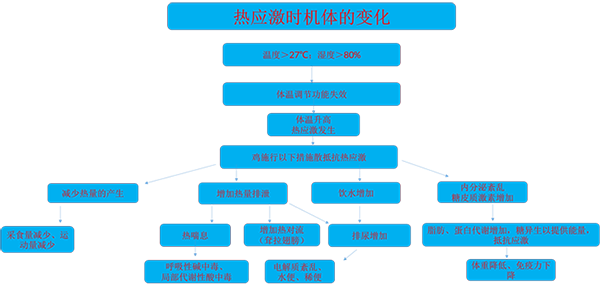The hazards of heat stress in poultry
As the temperature rises, the threat of heat stress to poultry farming becomes increasingly severe. Under sustained high temperatures (30 ℃~35 ℃), the decrease in poultry feed intake is more significant, and the longer the high temperature persists, the more the decrease in feed intake. The decrease rate can reach 40%~45% after 6 days of 35 ℃. And the larger the weight, the greater the impact.

Heat stress can cause acute stress reactions in chickens, including endocrine disorders, acute acid-base poisoning and electrolyte imbalances, weakened immunity, decreased feed intake and production performance, and in severe cases, mass death. High temperatures can cause the chickens to inhale faster, have faster heartbeats, drink more water, and when their body temperature reaches 45 ℃, their breathing becomes rapid, their comb turns pale, leading to pathological breathing, flaccidity, heat shock, death, etc. If the ambient temperature is 43 ℃ for 2 hours, 41 ℃ for 3 hours, it will cause poultry death, and if 39 ℃ lasts for 6 hours, 40% of chickens will be at risk. When there is a lack of water or insufficient drinking water, it will increase the heat stress response, and the body temperature of poultry will rapidly rise, accelerating death;

How to prevent heat stress
The key measure to prevent heat stress in chickens is to cool down while feeding appropriate anti stress products to assist the flock in resisting heat stress.
1、 Equipment maintenance
Equipment is an important means of cooling the chicken flock, and we must ensure that the cooling equipment operates well at critical moments, be prepared and prepared, in order to prevent accidents from happening.
1. Timely maintenance of circuits and generators should be carried out, with monthly inspections to avoid unnecessary injuries caused by accidents. Ensure that the equipment does not fall off the chain at critical moments. Prepare sufficient oil for power generation, and if conditions permit, prepare another generator.
2. Testing of cooling equipment. Including water curtain system, fan system, and spray system for extreme temperature.
2、 Cooling measures inside the building
Studies have shown that in typical hot summers, the heat production of chicken flocks accounts for 97% of the total heat production in meat chicken coops. This indicates that adding indoor insulation layer as per conventional advice is almost useless, as most of the heat is generated by chickens. Indoor cooling is an important measure to prevent heat stress in chicken flocks.
1. The wet curtain system should be intervened in a timely manner. Do not wait for the temperature to rise before opening it. The wet curtain is a temperature control device, not a cooling device.
2. The transition between horizontal and vertical ventilation should be timely, but it should also be prevented from being rushed.
3. Manually spray cold water to reduce space temperature; Sprinkle cold water on the ground to increase evaporation and heat dissipation.
4. Reduce heat intake and ensure a cool interior; Strengthen ventilation and heat dissipation to reduce the temperature inside the building.
5. Provide sufficient cool drinking water to alleviate the impact of high temperatures; Strengthen feeding management and enhance the temperature regulation ability of chickens.
3、 Suitable heatstroke relief and cooling products to prevent heat stress.
In situations where heat stress has already occurred and cooling measures are insufficient to control the temperature of the chicken coop, the use of appropriate anti stress products is a good way for us to reduce the impact of heat stress on the chicken flock and minimize losses.
1. Supplement electrolytes and correct osmotic pressure in the body.
Chickens release heat by drinking a large amount of water and urinating, and a large amount of electrolytes are excreted outside the body through urine, causing electrolyte imbalance in the body, mainly consisting of K+, Na+, and Ca2+. Causing a decrease in osmotic pressure within the body, if the osmotic pressure is not corrected, tissue exudate may occur. Some chickens that died due to heat stress observed at the autopsy site may have pericardial effusion, which is the reason for this. Timely supplementation of these cations can prevent the occurrence of such consequences.
2. Correct acid-base balance and prevent the occurrence of respiratory alkalosis and metabolic acidosis.
Chickens expel heat from their bodies by rapidly breathing through their mouths. At this time, a large amount of CO2 is excreted from the body, causing an increase in blood pH and leading to respiratory alkalosis. Due to the large amount of blood distributed on the surface of the skin to dissipate heat and rapid breathing, metabolic acidosis occurs in the body's cells and tissues due to hypoxia. Respiratory alkalosis and metabolic acidosis are important causes of acute mass mortality caused by heat stress.
3. Inhibition of glucocorticoid production
When heat stress occurs, the levels of glucocorticoids in the body increase. The increase in glucocorticoids accelerates protein and fat breakdown, as well as gluconeogenesis, in animals to produce enough energy to resist stress. However, glucocorticoids also inhibit immune system activity.
4. Substances that provide rapid energy replenishment
Cellular resistance to heat stress requires the involvement of energy. The main purpose of increasing glucocorticoids during heat stress is to rapidly generate energy in the body to counteract the adverse effects of heat stress. By quickly replenishing energy, the release of glucocorticoids can be reduced, their side effects can be minimized, and the body can effectively combat heat stress.